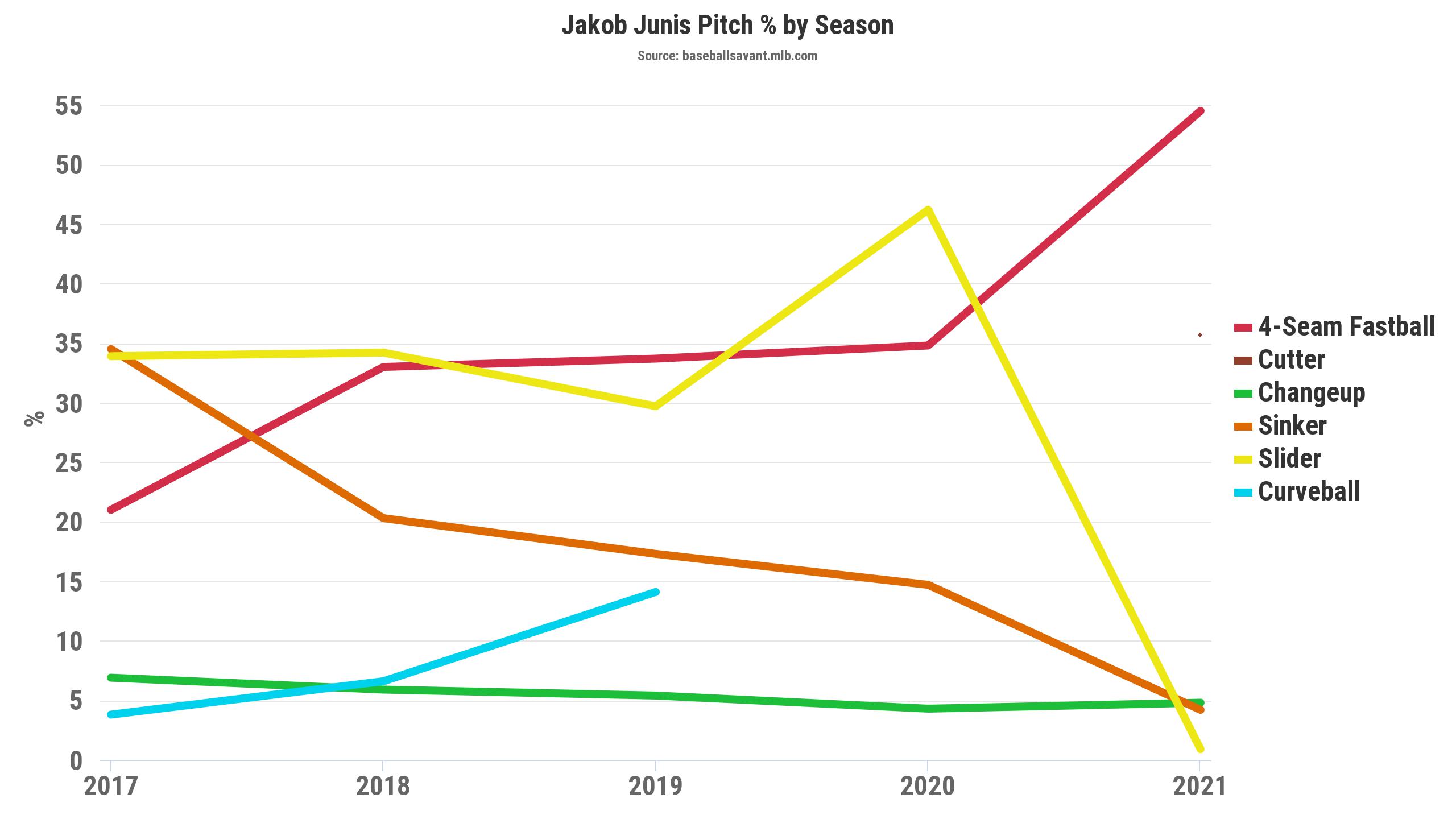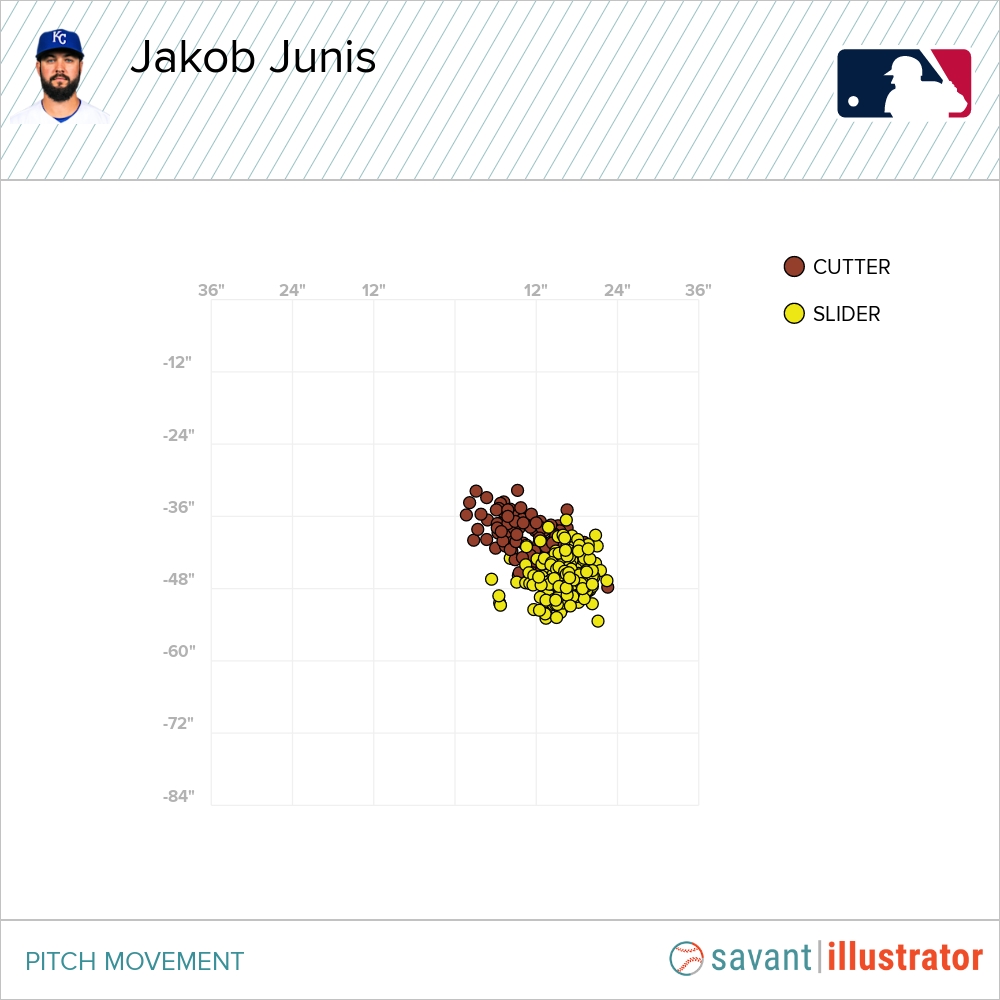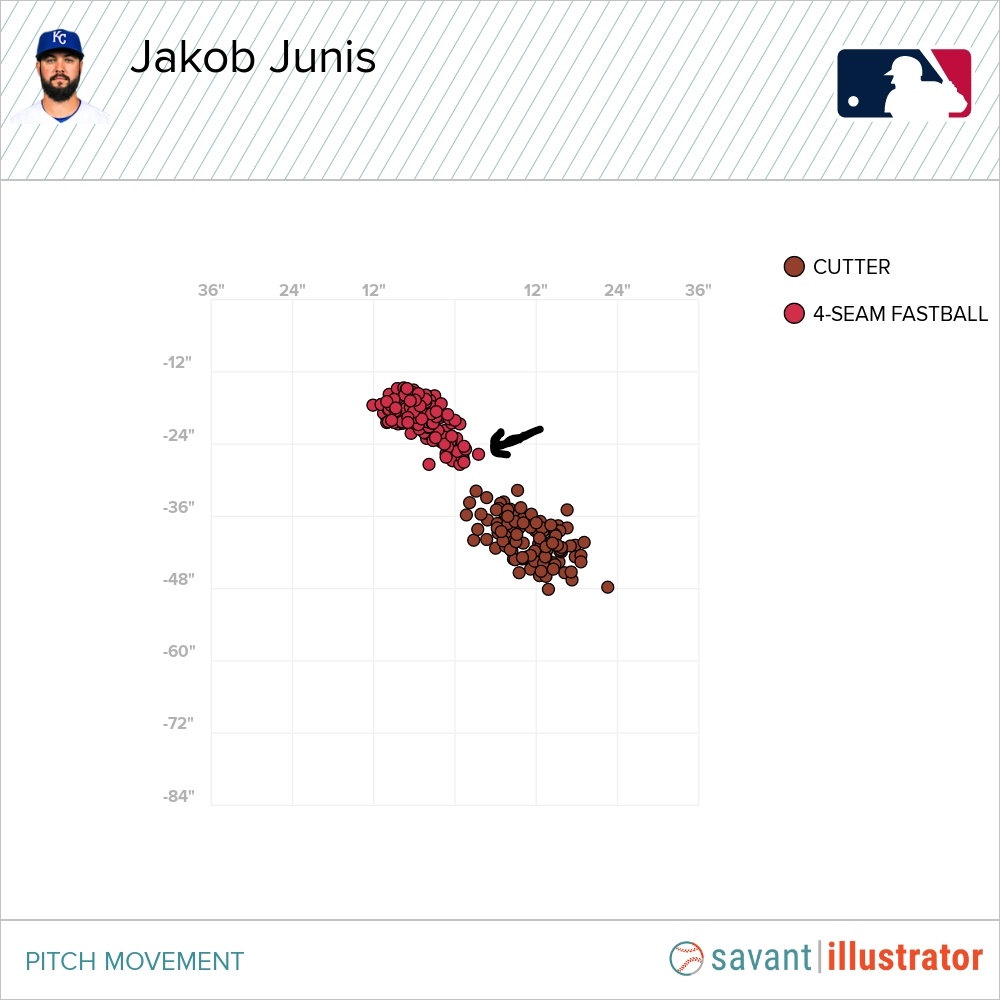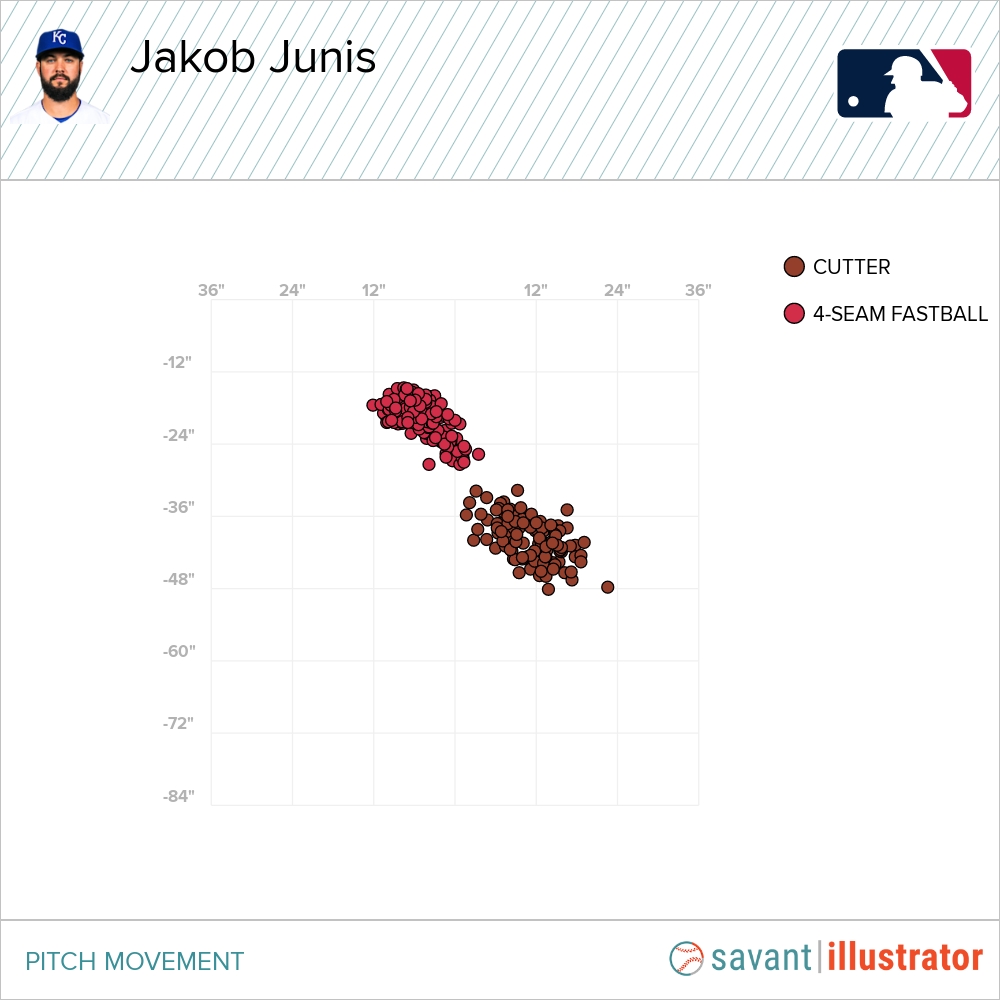This is a cautionary tale about falling a little too bit too deep down the rabbit hole, as Kansas City’s hot start has tempted many of us to do to at this early juncture. This was initially going to be about cutters. Anecdotally, the first few weeks of this weird and wild season was giving me the impression that cutter usage was on the rise. Seeing Joe Musgrove twirl a no-no with a newfound cutter while Corbin Burnes ran through the league upping his cutter usage to over 50% did feel like something representative; it felt as if cutters were popping up everywhere where before there had been sinkers and even four-seamers. A quick look at broad usage numbers would seem to back this up. According to Statcast, we’re seeing a nearly 50% increase in cutter usage league-wide over the past five years, with the rate on pace to increase for the fifth consecutive season:
| Year | Cutter % | % +/- |
|---|---|---|
| 2008 | 4.8 | — |
| 2009 | 4.9 | 0.1 |
| 2010 | 5.1 | 0.2 |
| 2011 | 5.7 | 0.6 |
| 2012 | 5.4 | -0.3 |
| 2013 | 5.4 | 0 |
| 2014 | 5.8 | 0.4 |
| 2015 | 5.4 | -0.4 |
| 2016 | 4.8 | -0.6 |
| 2017 | 5.3 | 0.5 |
| 2018 | 5.6 | 0.3 |
| 2019 | 6.4 | 0.8 |
| 2020 | 6.8 | 0.4 |
| 2021 | 7.2 | 0.4 |
Somewhat interestingly, the proportion of qualified pitchers with a functional cutter (>5% usage) has more or less held steady since 2017, indicating that the league-wide uptick comes more from pitchers leaning on the cutters that they already have, rather than a bunch of new cutters appearing out of nowhere. A look at the biggest jumps in individual cutter usage between 2020 and 2021 supports this on the surface, with some high-profile names taking their cutter from the depths of the secondaries into something resembling a primary pitch:
| Rk. | Pitcher | 2021 FC% | 2020 FC% | ▲FC% |
|---|---|---|---|---|
| 1 | Junis, Jakob | 35.7 | 0 | 35.7 |
| 2 | Mayers, Mike | 52.3 | 24.2 | 28.1 |
| 3 | Burnes, Corbin | 53.7 | 31.5 | 22.2 |
| 4 | Musgrove, Joe | 24.3 | 6.4 | 17.9 |
| 5 | Gibson, Kyle | 15.6 | 0.4 | 15.2 |
| 6 | Montgomery, Jordan | 21.8 | 6.7 | 15.1 |
| 7 | Alexander, Tyler | 30.5 | 17.2 | 13.3 |
| 8 | Fedde, Erick | 28.7 | 16.6 | 12.1 |
| 9 | Yarbrough, Ryan | 46.5 | 36 | 10.5 |
| 10 | Anderson, Tyler | 28.3 | 18.1 | 10.2 |
| 11 | Wacha, Michael | 36.7 | 27.1 | 9.6 |
| 12 | Plutko, Adam | 37 | 30.5 | 6.5 |
| 13 | Hill, Rich | 8.8 | 3.6 | 5.2 |
Our own Cole Bailey gave us an excellent breakdown of Kyle Gibson’s brand-new cutter a few days ago, and I think Gibson’s line of thinking about the cutter’s use as both a whiff and groundball-getter will be worth remembering when considering this overall trend. Unfortunately, I didn’t quite get to push that line of thinking this week, because, hey, look, Jakob Junis!
I know he just got demoted to the pen and all, but I had to stop and say hi to an old friend of the site. That looks like a cutter that truly has come from nothing. Given Junis’s surprisingly solid start to the 2021 campaign after getting rocked to the AL Central doghouse for most of 2020 and 2019, it looked initially like there might be some serious under the hood changes worth considering here, particularly given the constant state of chaos and fluctuation that has characterized his arsenal during his big league stay:
| Year | G | IP | ERA | FIP/xFIP/SIERA | K% | BB% | fWAR | bWAR |
|---|---|---|---|---|---|---|---|---|
| 2017 | 20 | 98.1 | 4.30 | 4.55/4.77/4.49 | 19 | 5.9 | 0.9 | 1.5 |
| 2018 | 30 | 177 | 4.37 | 4.64/4.13/3.98 | 21.6 | 5.7 | 1.5 | 1.7 |
| 2019 | 31 | 175.1 | 5.24 | 4.82/4.63/4.63 | 21.3 | 7.5 | 1.5 | 1.1 |
| 2020 | 8 | 25.1 | 6.39 | 6.23/4.77/4.72 | 16.7 | 5.3 | -0.2 | -0.2 |
| 2021 | 6 | 23.1 | 3.47 | 2.25/3.21/3.38 | 28.7 | 7.4 | 0.7 | 0.5 |
The cutter comes so out of nowhere that you probably won’t be able to find it unless you know to look for the little brown speck about the 35% line. If anyone reading this knows anything about Junis, the wildest thing about this chart is that he appears to have completely ditched the one even remotely above-average pitch he’s ever been known for, for one he’s never even thrown in the majors prior to now. And he’s also now seeing better results than ever, sniffing above-average strikeouts for the first time in his career for a big run-prevention turnaround that’s even starker when you see that most ERA estimators saw him as a high-4s, low-5s type even when he was having early-career success. Wherefore art thou, o slide piece?
If something smells off, then your nose is good. Baseball Savant is almost universally the best source for pitch arsenal data, but it can lie to us sometimes. Especially when we’re dealing with a pitcher like Junis, who been quite inconsistent and in-flux in terms of arsenal and results, we can usually learn something from the discrepancies that naturally pop up between the different sources of pitch data. Disagreements are fairly common, and while Savant’s cameras are generally more accurate than Pitch Info’s stringers—especially because they typically call the pitch what the player themselves calls it—the latter seem to have a better grasp on what Junis is doing, for the time being:
| Source | Four-Seam | Sinker | Slider | Curve | Change | Cutter |
|---|---|---|---|---|---|---|
| Hawkeye (Baseball Savant) | 54.5% | 4.2% | 0.9% | 0.0% | 4.8% | 35.7% |
| Pitch Info (Baseball Prospectus/FanGraphs) | 49.4% | 4.2% | 35.4% | 1.2% | 4.8% | 5.1% |
The math actually checks out fairly nicely. Savant is now calling his slider a cutter, and probably grouping in the ~5% cutters he’s throwing in with his four-seamer. It’s not the first time this has been pointed out, either, as Twitter user Brett Bredemeier was first to the punch a few days ago, with reference to our own Nick Pollack himself, who I could almost hear sigh audibly through the Discord DM when I asked him about Junis:
I’ve seen a lot of what I think is misinformation floating out there about Junis’s new cutter, just as much from Royals reporters/bloggers as national guys. The main culprit is that most rely on savant/statcast’s pitch data, which I think is clearly mislabeling Junis’ slider
— Brett Bredemeier (@BrettBredemeier) April 28, 2021
@PitcherList is one of the few I’ve seen be sharp enough to point out that the “new” cutter, as defined by statcast, is really just his old slider. Nick is right, but what he is missing is I think there IS a new pitch in there, in addition to his old slider, if you look closer
— Brett Bredemeier (@BrettBredemeier) April 28, 2021
Indeed, it really doesn’t take much deep diving to see that what Savant calls this a cutter is in fact the slider of yesteryear, albeit with a few clear tweaks:
| Year | Pitch Name | Usage | MPH | Spin | V-Mov | H-Mov | Spin Direction | Active Spin | CSW% | wOBA | xwOBA |
|---|---|---|---|---|---|---|---|---|---|---|---|
| 2017 | Slider | 33.9% | 81.3 | 2282 | 44.2 | 11.5 | 36.8% | .274 | .254 | ||
| 2018 | Slider | 34.2% | 82.2 | 2474 | 45.2 | 14.5 | 34.2% | .234 | .242 | ||
| 2019 | Slider | 29.7% | 82.4 | 2522 | 43.3 | 14.7 | 33.3% | .201 | .215 | ||
| 2020 | Slider | 46.2% | 80.1 | 2435 | 45.7 | 16.3 | 8:30 | 62% | 29.1% | .328 | .318 |
| 2021 | Cutter | 35.7% | 83 | 2523 | 39.5 | 10.9 | 8:45 | 34 | 40% | .115 | .202 |
That’s a lot of information, so let’s just go one column at a time, and we can learn something about what the process here seems to be. Starting at the far right, we saw that Junis’s slider suddenly lost a whole lot of effectiveness in 2020, which tracks well with the bottoming-out of his overall results and a slow but steady slide in CSW% that may have been a canary in the coal mine.
With his rotation spot already more or less lost, this was clearly enough to get Junis to keep messing with the pitch’s properties even beyond Savant’s misclassification. After dropping to an 80 MPH average velocity last year, giving it more slurvy drop and sweep than ever, Junis has tightened it up considerably in 2020. He’s added both a bunch of extra velocity and a bunch of gyro spin, which we can see in the 30% drop in active spin rate, both of which mean that although it’s still very much a slider, it’s acting a tiny bit more cutter-ish, with less drop and tighter side-to-side movement than its ever had before. It doesn’t just show up in the averages, either. When we look at a plot of Junis’s “cutters” this season overlayed with his sliders from 2020 and 2019, we can see that he’s still finding new ways to squeeze something out of his only real out pitch. Here are this season’s cutters:
Now let’s throw last year’s sliders on top:
Just for good measure, lets check that with 2019’s sliders, when it still resembled a potentially elite pitch:
It’s already clear that the pitch is doing a lot of different things that it wasn’t doing last year, and the smattering of brown circles on the left in the 2019 data indicates that even though it’s mostly the same pitch, it’s doing things that it hasn’t necessarily done in the past. That’s a potentially important little detail and brings us back to the reason I’m talking about this to begin with. I believe Savant is calling Junis’s slider a cutter because they (correctly, in my opinion) err on the side of calling a pitch what the pitcher calls it, and we saw multiple stories this spring of Junis attempting to spice up his arsenal with a new cutter. Unfortunately for Junis, while the return of the slider is very good news, it appears that Savant went and called his slider a cutter because, at least in terms of pure movement, pitch trackers are having a lot of difficulty distinguishing the cutter from his regular four-seamer:
This chart makes me think one of either two things is happening. Either the cutters he’s throwing are bleeding together badly with a certain subset of four-seamers he already tends to cut a little bit, or he’s throwing the cutter a whole lot more than Pitch Info thinks he is, meaning that the entire lower-right subset of four-seamers are actually misclassified cutters. If we look at a similar Baseball Savant chart, we can see the two different types of “four-seamers” pretty clearly, though they’re not as distinct as one would like:
Some of you are probably screaming at me (internally, I hope!) to stop looking at charts and watch some actual pitches. Seen in action, this isn’t a particularly dramatic or interesting cutter, but you can see how it gets in on Adam Frazier and Colin Moran’s hands just a liiittle bit too much to do anything with:
I’m now 1500 words into this without being able to say much of substance about cutters or Jakob Junis, and without mentioning that in spite of all that his fastball is still getting absolutely blitzed to the tune of a .472 xwOBA. That’s not going to play no matter how good his slider or cutter or anything else is.
That fastball being what it is, this whole pitch classification snafu can be an unintentional window into how Junis is continuing to fight to hang on to a big league spot even though he pretty clearly doesn’t have too much in the way of big league stuff. The slider/cutter distinction can be a tough one to make for cameras like the one MLB uses—and also colloquially—because they exist on essentially adjacent areas of the spin/velo/tilt spectrum, to the point where the line between one and the other is far from obvious. What I mean is that in many cases, a cutter is basically just a baby slider, and a hard slider is often essentially a cutter. Whether a pitch is labeled a slider or cutter is often more a matter of the pitcher’s preference and parlance more than there being a concrete definition of one or the other.
Take Jacob deGrom’s famously hard slider. Alex Chamberlain’s fun little pitch similarity tool, which is great for making points like these, tells us that when you strip away what deGrom himself actually calls it, it’s pretty much a tossup for what you might otherwise classify it as:
Even though it’s showing up in entirely convoluted ways, when all of those charts up top are put together, I’m seeing a pitcher who’s learning how to manipulate the little they’ve got in the way of stuff on a pitch by pitch basis to get by. Most of the time, when a pitcher’s stuff “runs together,” meaning their pitches stop having super distinct movement profiles and start to resemble each other, it’s a pretty bad thing. It means more pitches appear to act similarly out of the hand, decreases deception, and makes everything easier to hit. That might very well be what’s happening here with Junis’s fastball and slider—look at how much bigger that gap was in 2019 than it is now:
Again, most of the time, this would be a bad thing, but we already know Junis isn’t somebody who’s going to survive on the strength of hammering the same thing over and over again. He needs some deception in his game and being able to manipulate the shapes of two or three different pitches so that they sometimes resemble each other and sometimes don’t is certainly a way of getting to that deception.
At the same time, he did just get demoted to the bullpen, so it’s not as if the team clearly knows something I don’t here. This new cutter might be trashed by the All-Star Break, and all of the whiffs Junis is getting to this point might simply be a function of making all of those tweaks to his new cutter slider. And even those might all disappear tomorrow! All the same, he’s an interesting case study on how in a time in which surveilling players is easier than ever, adjustments are not always what they seem. Junis’s new cutter is actually his old slider, which isn’t his old slider at all, and is actually different from his new cutter. It’s early days yet, but there’s some indication that five years into his career, he may have found a new way to squeeze even more life out of the little things that got him to the majors in the first place.
(Photo by John Cordes/Icon Sportswire)











Nice work as always and thanks for the shoutout. Based on comments from his brother who helped him develop the new cutter, sounds like you’re absolutely right on both points that he is A) (trying to) throw way more cutters than pitch info thinks he is and B) most of these cutters have been bleeding badly into his 4 seamer range. The Pittsburgh start was the first where they started to get the separation between the two they were getting in the offseason. Glad this was at least mildly interesting to someone else!
Thanks for the extra info, awesome to hear I didn’t totally pull it out of the ether! Also, apologies for misspelling your name in the original post—it’s been fixed!